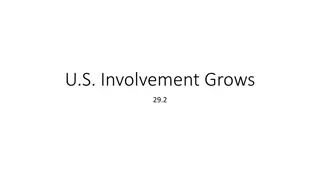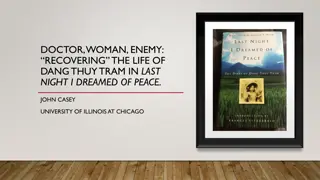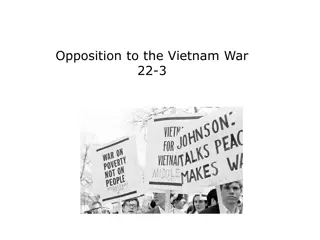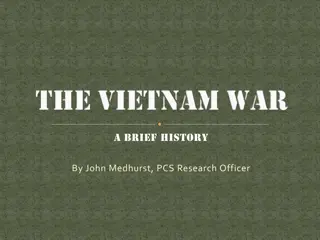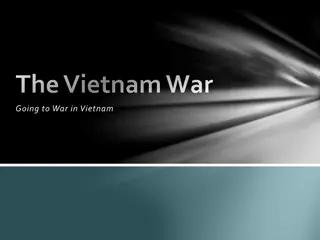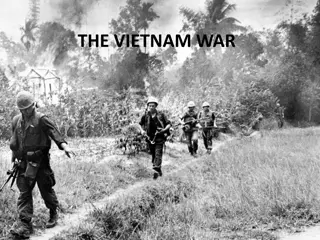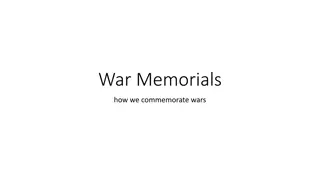Understanding the Interdisciplinary Approach Through the Vietnam War
Interdisciplinarity involves combining multiple fields of study to gain a deeper understanding of a subject, such as history. American Studies serves as an example of interdisciplinary exploration, with the Vietnam War being a key case study. The conflict's impact was vast, with significant costs, loss of life, and lasting repercussions on both American and Vietnamese societies.
Uploaded on Sep 10, 2024 | 0 Views
Download Presentation

Please find below an Image/Link to download the presentation.
The content on the website is provided AS IS for your information and personal use only. It may not be sold, licensed, or shared on other websites without obtaining consent from the author. Download presentation by click this link. If you encounter any issues during the download, it is possible that the publisher has removed the file from their server.
E N D
Presentation Transcript
THINKING INTERDISCIPLINARY IN HISTORY: VIETNAM AS CASE STUDY BAAS History Resources Series: History Skills
WHAT IS INTERDISCIPLINARITY? Interdisciplinarity, or interdisciplinary studies, relies on combining two (or more) fields of study to better understand a subject. How might we learn more about history from studying fields like: Literature? Geography? Sociology? Music? Film Studies? Politics? Art History? Psychology? Science? Theatre Studies? Subjects like Area Studies, Black Studies, and Gender Studies frequently take this approach. the disciplines are the place where we begin, but not where we end. -Allen F. Repko
AMERICAN STUDIES American Studies is an interdisciplinary field, which draws on multiple strands of scholarship to develop understanding of the Americas. American Studies gained popularity in the UK in the context of the Cold War, with stakeholders feeling the discipline would bolster the special relationship between the two countries. Various organizations (including the Rockerfeller Foundation) would fund the the Fulbright Conferences, where the British Association of American Studies (BAAS) was formed. Since then, American Studies has expanded to encompass a more transnational approach, including increased consideration of Canada, the Caribbean, and Central and Southern America. Throughout its history, interdisciplinarity has been key to American Studies.
INTERDISCIPLINARY CASE STUDY: THE VIETNAM WAR The Vietnam War was a conflict between the communist North Vietnam (and its Southern allies the Viet Cong) and South Vietnam. North Vietnam was supported by the Soviet Union, and South Vietnam was supported by the United States. For the United States, Vietnam was originally thought of in terms of containment and preventing the spread of communism further. The Truman Doctrine in 1947 articulated this. US military presence in Vietnam increased during President Johnson s administration. After an alleged attack by North Vietnamese vessel on a US ship, Congress passed Gulf of Tonkin resolution in 1964. By 1968 there were more than half a million troops in Vietnam. The media was actively involved in covering Vietnam. The Tet Offensive in 1968 where US troops were surprised by mass uprisings across South Vietnam marked a turning point in failing support for the war, as images of intense fighting were broadcast into American homes. The conduct of the war was brutal, with bombings, chemical warfare, and search and destroy missions that often targeted both soldiers and civilians. Atrocities such as the My Lai massacre where US forces killed hundreds of unarmed civilians further outraged the public once they came to light. Due to mounting costs, loss of life, and huge domestic pressure, the United States withdrew in 1973. Saigon fell in 1975, signaling the final loss of the war.
WHAT WAS THE IMPACT OF THE WAR? Costs: An estimated $167 billion was spent on the war. Indirectly, it placed massive inflationary pressures on the US economy. 2.7 million US citizens served in Vietnam. By the time that Saigon fell in April 1975, some 58,000 American soldiers had lost their lives, along with perhaps as many as 3 million Vietnamese (both soldiers and civilians). Howard Zinn called the war in Vietnam as the theatre of the absurd. The war caused a bitter split within the Democratic Party. It also further radicalised the student New Left, who formed a vocal Anti-war Movement. Public opinion on Vietnam was mostly negative, with a marked fall after the Tet Offensive of 1968. What does adopting an interdisciplinary approach tell us about the impact of the Vietnam War?
THE VIETNAM WAR: LITERATURE Pilar Marin categorized the literature of the Vietnam into four categories: Straight journalism, such as Dispatches (1977) by Michael Herr. Diaries, such as The Killing Zone (1978) by Frederick Downs. Stories of fictitious characters in real events, such as Fields of Fire (1978) by James Webb. Autobiographical works that provide psychological insight into the protagonist, such as A Rumor of War (1977) by Philip Caputo. A review of this work reads: Caputo s troubled, searching meditations on the love and hate of war, on fear, and the ambivalent discord warfare can create in the hearts of decent men, are among the most eloquent I have read in modern literature. William Styron,The New York Review of Books. War is seen as the test of manhood, an initiation rite. These novels of Vietnam, like those of World War I and World War II reveal to the reader characters, all of them young men, who are deeply worried as to what their behavior will be when the terrible moment comes. Pilar Marin.
EXCERPT FROM A RUMOR OF WAR The discovery that the men we had scorned as peasant guerrillas were, in fact, a lethal, determined enemy and the casualty lists that lengthened each week with nothing to show for the blood being spilled broke our early confidence. By autumn, what had begun as an adventurous expedition had turned into an exhausting, indecisive war of attrition in which we fought for no cause other than our own survival. - Philip Caputo, A Rumor of War (New York : Holt, Rinehart and Winston, 1977).
THE VIETNAM WAR: FILM STUDIES There have been dozens of films focusing on American soldiers experiences in Vietnam, including dramas [The Deer Hunter (1978), Full Metal Jacket (1987)], and comedies [Good Morning, Vietnam (1987)]. One of the most famous Vietnam films is Apocalypse Now (1979), directed by Francis Ford Coppola. It is based on the novella Heart of Darkness by Joseph Conrad (1899). The film follows Captain Willard, who is ordered to assassinate Colonel Kurtz. As he carries out his mission down the rivers of South Vietnam, he travels further into the madness and corruption of the soldiers around him. The film has had a significant impact on popular culture, with iconic quotes such as I love the smell of napalm in the morning and The horror, the horror. The latter quote is the last words of Kurtz before he dies, which are also present in Conrad s novella. Despite Francis Ford Coppola s recent assertion that Apocalypse Now (1979) is not an anti-war film, the movie visually and auditorily falls squarely into the anti-war film movement in its challenging of the justness of the American cause and of the American soldier. - Bianca Berman.
Access the video clip here: https://www.youtube.com/watch?v=Jts9suWIDlU Watch the scene of Lieutenant Colonel Bill Kilgore (played by Robert Duvall). What does Duvall s performance convey about his character s attitude to the war?
THE VIETNAM WAR: VISUAL CULTURE The Vietnam war came to be known as the first living room war. Extensive media coverage, including television and photography, meant that images of the conflict appeared in people s homes. By 1968, there were about 600 accredited journalists in Vietnam. Photography had a huge impact on public opinion. For instance, in Eddie Adams took a photograph during the Tet Offensive (1968) that showed a police chief about to execute suspected Viet Cong Officer Nguyen Van Lem. The haunting image caused many people in the United States to question the morality of the war. Patrick Hagopian argues that the memory of the Vietnam has been defined by a narrow pool of images: The images that constitute the visual archive of the war in books, documentaries and the recollection of commentators are not moving images but still photographs. And everyone who refers to them generally agrees what those images include. A typical summary of this photo gallery reads as follows: Unlike previous wars, Vietnam was a war of images, most of them horrible: Buddhist monks setting themselves on fire; General Loan shooting a VC suspect in the head; bodies lying in the garden of the US embassy; a naked child screaming in pain from napalm burns; four students lying dead in Ohio .1 In addition to these images, other commentators cite Ron Haeberle s photograph of the My Lai massacre and a handful of others.
This April 1968 file photo shows the first sergeant of A Company, 101st Airborne Division, guiding a medevac helicopter through the jungle foliage to pick up casualties suffered during a five-day patrol near Hue, Vietnam, April 1968.Art Greenspoon / AP Photo. Source: https://www.ap.org/ap-in-the-news/2018/how-an-iconic-ap-photo-showed-toll-of- vietnam-war-to-america How is this photograph composed? What does this tell us about the Vietnam War? What else might we interpret?
THE VIETNAM WAR: GEOGRAPHY The geographic consequences of the Vietnam War are still being explored. The use of ecological weapons such as Agent Orange and Napalm had devastating impacts on the environment in Vietnam. Sustained bombing campaigns left craters all over the South Vietnamese landscape in more tropical regions, these became hotbeds of mosquitos and diseases. Because of efforts to flood parts of Vietnam, water quality levels sharply decreased. Half of South Vietnam s forests were destroyed during the war. The US Air Force tried to modify the Vietnamese climate to induce devastating typhoons (Shaw, 2016). Ian G. R. Shaw argues that the Vietnam War demonstrated atmospheric warfare which continues to be employed today, through its use of ecological weapons, electronic battlefields (e.g. sensors and computers), and drones. Atmospheres are not neutral background to human life but the space of our subjectivity. Any attack waged against these spheres - as the Vietnam War exposed so viscerally is a violence launched against the very essence of the human condition.
THE VIETNAM WAR: MUSIC Music formed a huge part of the culture surrounding the anti-war movement. The war took place over a period of time that saw the shift of music from folk to rock, and was one of the major factors in the emergence of a counterculture movement. Examples of protest songs from the period include: Phil Och s I Ain t Marching Anymore (1965), Pete Seeger s Bring Em Home (1966), and Creedence Clearwater Revival s Fortunate Son (1969). The Rolling Stones were part of the British Invasion of the 1960s. This marked an era where bands such as The Beatles, The Who, and the Kinks found major success in America. The Rolling Stones s song Gimme Shelter was inspired by multiple factors, put partly by the Vietnam War. It is one of the most widely distributed songs about the war: Well, it's a very rough, very violent era. The Vietnam War. Violence on the screens, pillage and burning. And Vietnam was not war as we knew it in the conventional sense. The thing about Vietnam was that it wasn't like World War II, and it wasn't like Korea, and it wasn't like the Gulf War. It was a real nasty war, and people didn't like it. People objected, and people didn't want to fight it ... That's a kind of end-of-the- world song, really. It's apocalypse; the whole record's like that. Mick Jagger, 1995. Does this make it an anti-war song?
WHAT DOES AN INTERDISCIPLINARY APPROACH TELL US? We can see that the Vietnam War had a significant impact on American politics and culture, including popular culture. A lot of culture has focused on the psychological effects of the war on American soldiers. Many sources represent the war as apocalyptic. It has also demonstrated the importance of anti-war efforts, in terms of challenging patriotic notions of war as always honorable. It is also interesting to see how culture has characterized the soldier in Vietnam, frequently emphasizing their youth. What other themes can you see emerging? How do these sources represent Vietnamese soldiers and citizens?
WORKS CITED Bianca Berman, The soldier as victim and aggressor: subverting the hero solider in Apocalypse Now, Dien Bien Phu, and White Badge, Small Wars & Insurgencies 34:5 (2023): 962-984. Eric Foner, Give Me Liberty! An American History (New York & London: W. W. Norton, 2005). Simon Hall, Rethinking the American Anti-War Movement (New York: Routledge, 2012). Patrick Hagopian, The Vietnam War in American Memory: Veterans, Memorials, and the Politics of Healing (Amherst: University of Massachusetts Press, 2009). David E. James, Rock and Roll in Representations of the Invasion of Vietnam, Representations 29.29 (1990): 78-98. Dylan Lovan, How an iconic AP photo showed the toll of Vietnam War to America, AP, 12 Feb 2018. https://www.ap.org/ap-in-the-news/2018/how-an-iconic- ap-photo-showed-toll-of-vietnam-war-to-america Heidi Slettedahl Macpherson and Will Kaufman, The State of (Dis)Union: American Studies in Britain, Prospects 30 (October 2005): 27-43. Pilar Marin, Dominant Themes in the Literature of the Vietnam War, Atlantis 3.1 (December 1981): 5-15. Public Opinion and the Vietnam War, Digital History, 2021. https://www.digitalhistory.uh.edu/active_learning/explorations/vietnam/vietnam_pubopinion.cfm Allen F. Repko, Rick Szostak, and Michelle Phillips Buchberger, Introduction to Interdisciplinary Studies (Thousand Oaks: SAGE Publications, 2013). John Carlos Rowe and Rick Berg (eds.), The Vietnam War and American Culture (New York: Columbia University Press, 1991). Ian G. R. Shaw, Scorched Atmospheres: The Violent Geographies of the Vietnam War and the Rise of Drone Warfare, Annals of the American Association of Geographers (2016): 1-17. Melvin Small, Antiwarriors: The Vietnam War and the Battle for America s Hearts and Minds (Wilmington, DE: Scholarly Resources, Inc., 2002). Howard Temperley, American Studies in Britain, American Quarterly 18.2 (Summer, 1966): 251-269. Tom Wells, The War Within: America's Battle Over Vietnam (Berkeley, Los Angeles & London: University of California Press, 1994).














